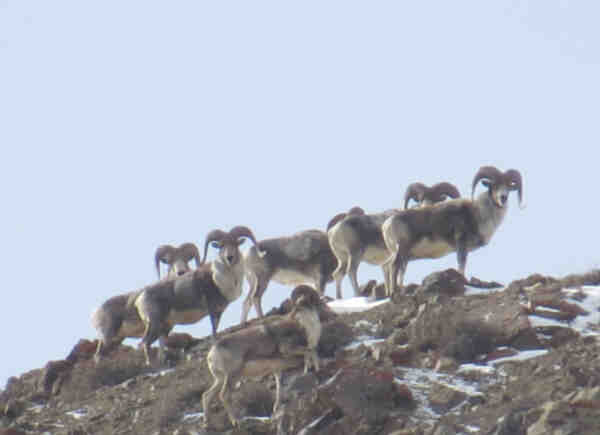Ovis hodgsoni
IUCN
LCBasic Information
Scientific classification
- name:Ovis hodgsoni
- Scientific Name:Ovis hodgsoni,Tibetan argali,Tibetan sheep, Dalai Lama argali, Altun Mountain argali, white-breasted argali, Tibetan argali, big monk argali
- Outline:Ungulata
- Family:Artiodactyla Ruminantia Bovidae Caprinae Argali
Vital signs
- length:120-200cm
- Weight:65-185kg
- lifetime:10-15years
Feature
The largest of all argali subspecies
Distribution and Habitat
Distributed in Nepal, India and the Qinghai-Tibet Plateau of China.
They like to live in semi-open alpine bare rock belts and undulating hills, with an altitude of about 2,500 to 5,500 meters. The argali in Hoh Xil is distributed in alpine grasslands, alpine deserts, alpine meadows and other environments in mountainous areas above 5,000 meters above sea level. In summer, they often move to the lower edge of the snow line. In winter, when the habitat is covered with deep snow, they move from high places to low valleys to live, with seasonal vertical migration habits.
Appearance
The body length is 1.2-2 meters, the shoulder height is 90-120 centimeters, and the weight is 65-185 kilograms. The shoulder height is equal to or lower than the hip height. The head is large, the neck is thick, and the tail is short. The limbs are short and thick, and the front of the hoof is particularly steep, which is suitable for climbing between rocks. There are infraorbital glands and hoof glands. There is a pair of nipples, located in the muzzle. The whole body is covered with coarse and short hair, but the neck is covered with longer hair. The adult male has a grayish color, the entire chest is flawless and the ruff is well developed. The color of the chest and abdomen is lighter, and the neck and hip spots are white. The hair color in front of the forelimbs is darker than that of other parts. The color of the back of the tail is the same as that of the back of the body. The hair color of the female sheep is darker than that of the male sheep.
The curved horns of the male T
Details
Tibetan argali, also known as Tibetan argali in English, is a typical mountain animal and was once a subspecies of argali.

The scientific Latin name of the Tibetan argali, one of its synonymous scientific names "Ovis ammon dalai-lamae" (also formerly "Argallo Altun Mountain subspecies"), is translated into Chinese as "Dalai Lama Argali". This was named in 1888 to commemorate the title or title of Dalai Lama in Tibetan Buddhism (this Dalai is not the same as the "Dalai"). In 1876-1877, during his second Central Asian expedition, Russian Nicolai Przewalski crossed the Altun Mountains from Ruoqiang to the Kunlun Mountains. He discovered Tibetan argali in the Zaisan-Saytin River Valley in Ruoqiang, Xinjiang (38 degrees north latitude, 89 degrees east longitude), which is in the transition zone between the southern Altun Mountains and the Kunlun Mountains. In addition, he also recorded the "white-breasted argali" in Qumalai County, Qinghai.
The Tibetan argali is generally considered to be the Tibetan subspecies of Ovis ammon. It is considered an independent species in the book Ungulate Taxonomy co-authored by British scholar Peter Grubb and Australian scholar Colin Groves. The 2019 edition of the Convention on International Trade in Endangered Species of Wild Fauna and Flora (CITES) and the China's National List of Key Protected Wildlife published in 2021 also adopt this statement, treating it as an independent species. However, as of February 2021, the IUCN Red List of Threatened Species and most data will still regard it as a subspecies of argali.
The Tibetan argali likes to live in semi-open alpine bare rock belts and undulating hills between mountains. They are distributed in alpine grasslands, alpine deserts, alpine meadows and other environments at an altitude of 2500-5000 meters. In summer, they often move to the lower edge of the snow line. When the snow in their habitat is deep in winter, they move from high places to valleys with lower altitudes. They are mainly active at dawn and dusk, and they also forage during the day in winter. They mainly feed on Gramineae, Allium and weeds. Their main natural enemies are wolves and snow leopards.
Tibetan argali rams mate in late autumn and early winter, with a gestation period of 150-160 days, and give birth in May to June of the following year, with 1-3 pups per litter. The pups have a strong ability to adapt to the environment. After birth, they can stand up and feed as soon as their fur dries. They can move with the female a few hours later, start to eat grass at around 1 month old, and the lactation period lasts for more than half a year. They are sexually mature at 1-2 years old.
The Tibetan argali (Ovis ammon hodgsoni), known as "Nayan" in Nepal, belongs to the family Bovidae in the order Artiodactyla. The species occurs in Nepal in the high mountains of Nepal in the Annapurna Conservation Area, near Mustang and north of Mustang District in Tibet. The number of Nepalese argali is unknown. However, it is probably rare as a total of only 77 argali were reported in 2005. The drastic decline in numbers is due to habitat loss due to competition with livestock and human encroachment. It is found throughout Nepal and is classified as Data Deficient. The legal status of the species in Nepal is protected under the National Parks and Wildlife Conservation Act, 1973.
Listed in the IUCN Red List of Threatened Species 2020 ver3.1 - Near Threatened (NT).
Listed in Appendix I, Appendix II and Appendix III of the 2019 edition of the Convention on International Trade in Endangered Species of Wild Fauna and Flora (CITES).
Listed in the first level of China's "National List of Key Protected Wildlife" (February 5, 2021).
Protect wildlife and eliminate game.
Maintaining ecological balance is everyone's responsibility!








